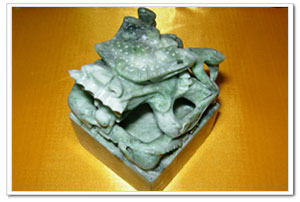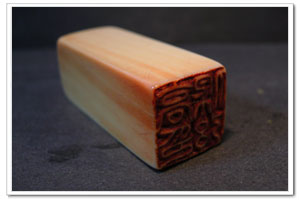The role of Chinese seals or Chinese chops in the culture can hardly be underestimated. For the last 3,000 years they have been used in official, private, even magic spheres. The earliest examples of seals come from the Shang Dynasty Very little is known about their usage at that early stage. It was only in the Spring and Autumn period (722-481 BC) that seals became common. Possession of the seal signified the conferral of the Mandate of Heaven; he who had the seal had the right to rule the empire. When Tang, the first ruler of the Shang Dynasty overthrew the last tyrant of the previous Xia Dynasty, he seized the royal seal and thus established his power.
 At the time of the Han Dynasty, the emperor had six seals, during the Tang he had eight, during the Ming over a dozen, and by the time of the Qing, there were several dozen, official imperial seals. Another type of imperial seal was the one the emperor used to indicate that a certain document was written in his own handwriting. Another was used by the emperors to appraise art objects. It was customary for collectors and connoisseurs of art to affix their seals on the surface of a scroll, painting or calligraphy. The imperial seal was affixed to paintings acquired by the imperial household. Many famous paintings from the Forbidden City have seals of generations of subsequent emperors on them.
At the time of the Han Dynasty, the emperor had six seals, during the Tang he had eight, during the Ming over a dozen, and by the time of the Qing, there were several dozen, official imperial seals. Another type of imperial seal was the one the emperor used to indicate that a certain document was written in his own handwriting. Another was used by the emperors to appraise art objects. It was customary for collectors and connoisseurs of art to affix their seals on the surface of a scroll, painting or calligraphy. The imperial seal was affixed to paintings acquired by the imperial household. Many famous paintings from the Forbidden City have seals of generations of subsequent emperors on them.
The calligraphy of the inscription changed a great deal over the long span of Chinese history. Approaching the Han Dynasty, the characters on the seal inscriptions tend to become thicker and more angular. From the Sui Dynasty (581-618), they become rounded and thinner, and during the Song and Yuan periods we can witness the spectacular jiudie (nine-folded) script. In the Qing period, most official seals were bilingual with the Chinese inscription on the right side and the Manchu on the left.
Official seals were conferred on officials as a token of their office and authority. These seals were usually small enough to be carried on the official's belt. There were regulations as to the material and shape of the handle, some had to be golden, some copper, some with a handle in the shape of a turtle, some of a camel. Up to the Eastern Han Dynasty (25-330), the color of ink used to affix official seals was regulated depending on the position of the owner; some officials had to use green ink, some purple, some yellow etc.
 Private seals were unregulated; therefore they show the largest variety in content, shape, size, material and calligraphy. They could have different inscriptions for different functions, such as seals of a person's name, a studio name, an auspicious phrase, a zodiac animal, an idiom and a collection appraisal mark. Seals carved with figures, creatures, vehicles and architecture belong to a special type of private seal that was popular in the Warring States period and Han and Jin dynasties (475 BC- 420 AD).
Private seals were unregulated; therefore they show the largest variety in content, shape, size, material and calligraphy. They could have different inscriptions for different functions, such as seals of a person's name, a studio name, an auspicious phrase, a zodiac animal, an idiom and a collection appraisal mark. Seals carved with figures, creatures, vehicles and architecture belong to a special type of private seal that was popular in the Warring States period and Han and Jin dynasties (475 BC- 420 AD).
Most ancient seals have a pierced knob on the top for handling and stringing. The knob is in the shape of a nose, an arched tile, a trapezoid, a serpent, a turtle, a camel or a horse. The type of handle was an indication of the rank of the person who owned the seal. Seals were mainly made of jade, stone, ceramics, bone and ivory. In the Ming Dynasty (1368-1644), stone seals became popular, and have remained popular ever since.

